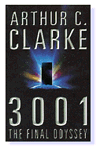
The full title, 3001, The Final Odyssey, says a lot. Although in theory there could be sequels, this could well be the last book that Clarke writes. HeÆs getting on a bit, he is suffering from post-polio syndrome and he has a mountain of correspondence to deal with. When I got in touch late last year, he pointed out that mine was one of 20 letters he had had to deal with in a single morning. But donÆt lose hope û he retires regularly, but has always come back for more to date.
3001 ties up many of the loose ends that litter the series. ItÆs also a neat bookend with the original, bringing back the main protagonists - astronauts Frank Poole and Dave Bowman along with computer HAL - even if the last two are merged into a single entity that is a program running on a super-computer û the great monolith on JupiterÆs moon Europa.
In 3001 we finally get to see whatÆs happening on the forbidden moon, though frankly itÆs something of an anti-climax. Most of the book, though is taken up with the two themes of Frank PooleÆs defrosting after a millennium in space and the attempt to prevent the monolith from destroying the solar system. Both are managed with ClarkeÆs usual mixture of smoothness and naivety, making the book a great page-turner, but each has problems.
 Travelling into the future is a hoary classic of science fiction, but none the worse for it. It can be easier to bring a historical figure to the present û take for example the 1979 film Time After Time, where H.G. Wells builds a time machine which both he and Jack the Ripper use to come forward to the future (it works better than it sounds). But Wells himself demonstrated the danger of taking someone from the present day into the far future. The potential for speculation is wonderful, we can be surprised and shocked alongside the main character with the changes that have taken place. But thereÆs a fatal tendency to turn the story into a boring discussion of the authorÆs pet topics.
Wells can drone on at great length about the ways his social theories have developed. ClarkeÆs love of engineering and dislike of religion are also given free rein. His picture of Earth in 3001 is perhaps too influenced by some of the SF engineering greats of the past û AsimovÆs Caves of Steel and NivenÆs Ring World û and not enough by the move away from hard technology. Maybe the engineer has had his/her day?
Travelling into the future is a hoary classic of science fiction, but none the worse for it. It can be easier to bring a historical figure to the present û take for example the 1979 film Time After Time, where H.G. Wells builds a time machine which both he and Jack the Ripper use to come forward to the future (it works better than it sounds). But Wells himself demonstrated the danger of taking someone from the present day into the far future. The potential for speculation is wonderful, we can be surprised and shocked alongside the main character with the changes that have taken place. But thereÆs a fatal tendency to turn the story into a boring discussion of the authorÆs pet topics.
Wells can drone on at great length about the ways his social theories have developed. ClarkeÆs love of engineering and dislike of religion are also given free rein. His picture of Earth in 3001 is perhaps too influenced by some of the SF engineering greats of the past û AsimovÆs Caves of Steel and NivenÆs Ring World û and not enough by the move away from hard technology. Maybe the engineer has had his/her day?
ClarkeÆs vision of the dissolution of organised religion seems more wish-fulfilment than extrapolation from history. His assertion that anyone with religious beliefs is actually insane is propped up with quaint notions like since religious beliefs can depend on where you are born, they must be untrue. As a logical argument, this creaks a bit. Just because most occupants of Peru (or Yorkshire for that matter) have never heard of entropy, doesnÆt mean you have to be mad to believe in it.
The other problem I have with 3001 is the way computer viruses are used. Clarke in his enjoyable afterword (donÆt be put off by the title, Sources and Acknowledgements) points out the parallels with the (independently developed) ending of the film Independence Day (about the only original thing in the filmÆs plot). But I find ClarkeÆs viruses unconvincing. The idea of a virus so terrible it has to be locked up because there was "not even the possibility of a cureà", one that works by convincing the computer that it was possible to complete an impossible task in a finite time, smacks too much of those trite TV and film plots where computers start literally to emit smoke under the effort of understanding an impossible statement.